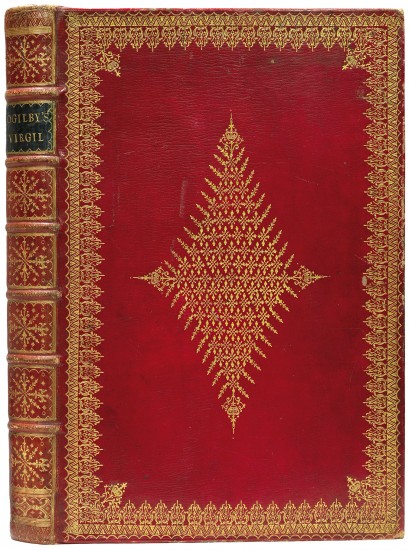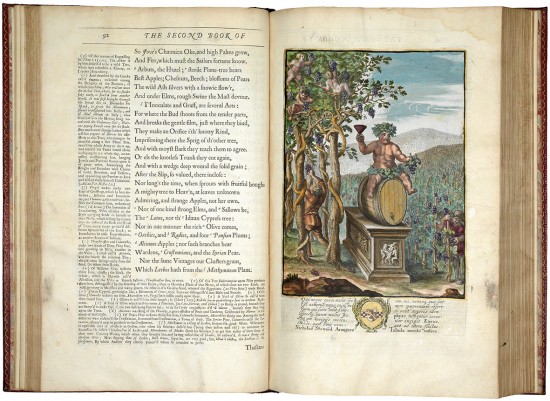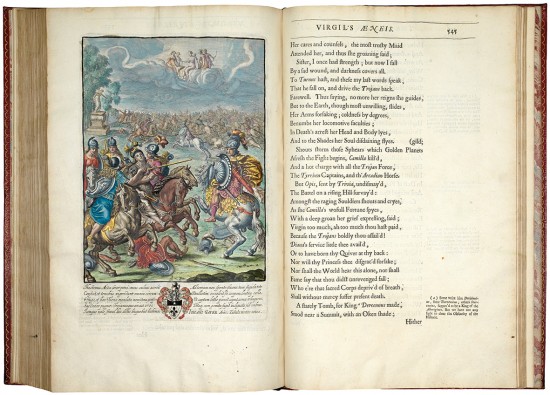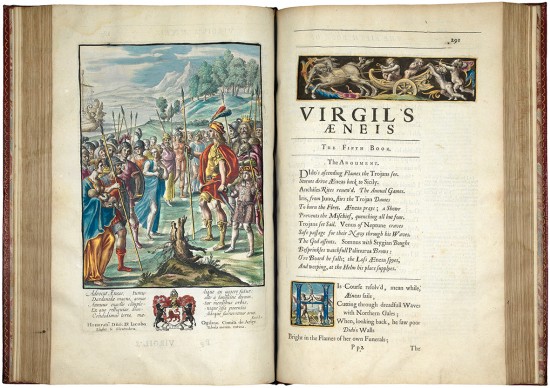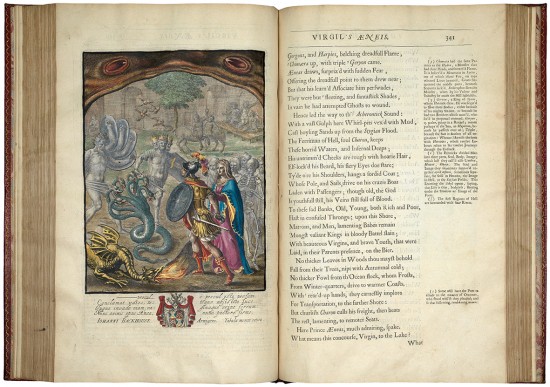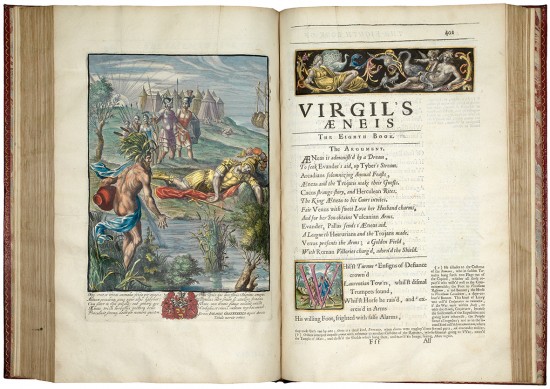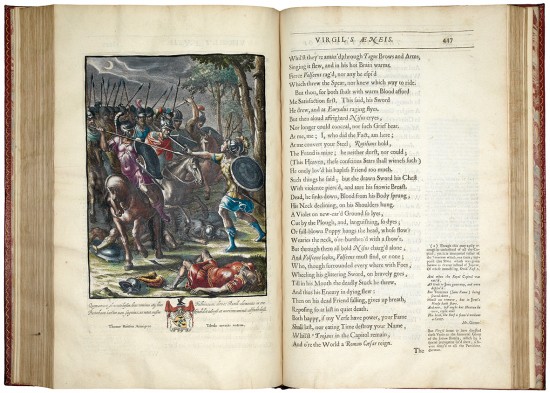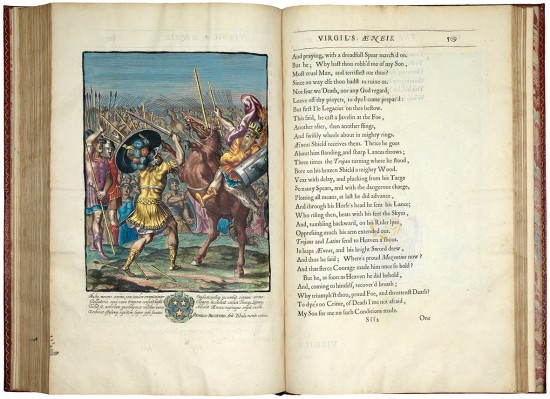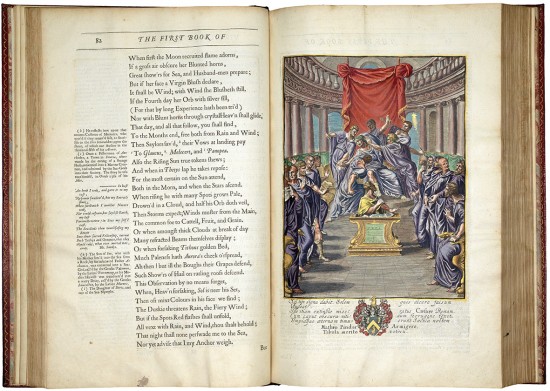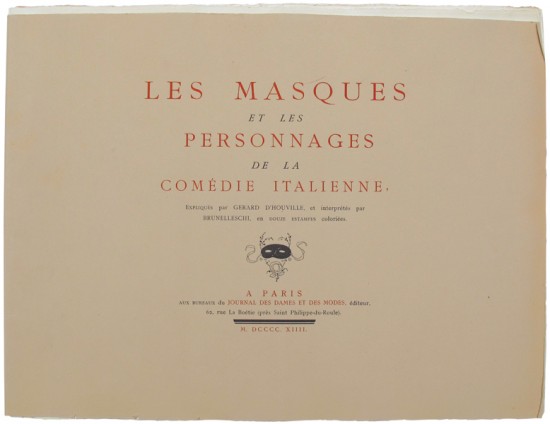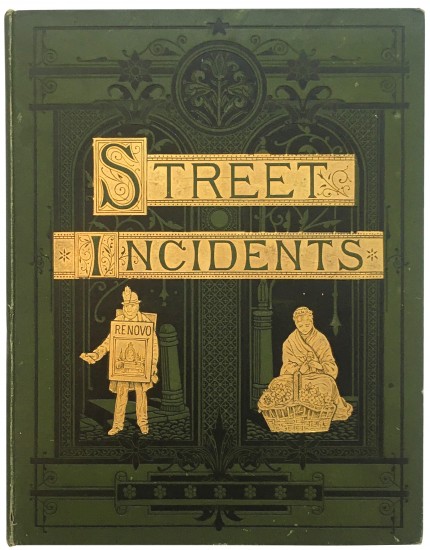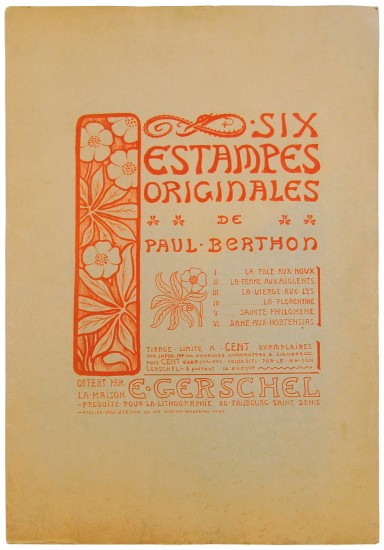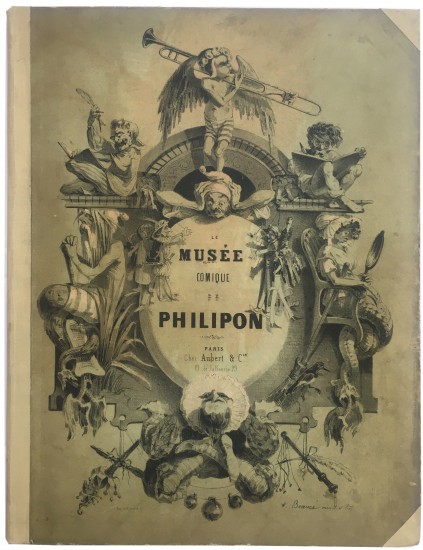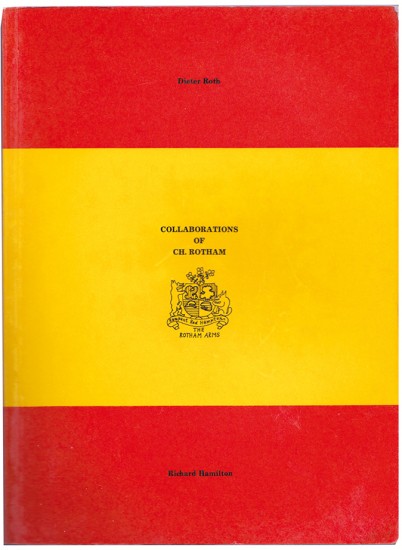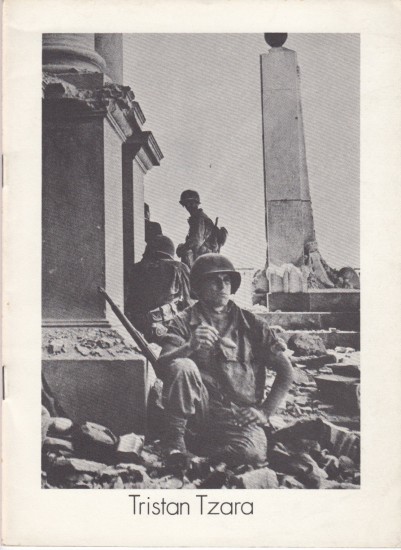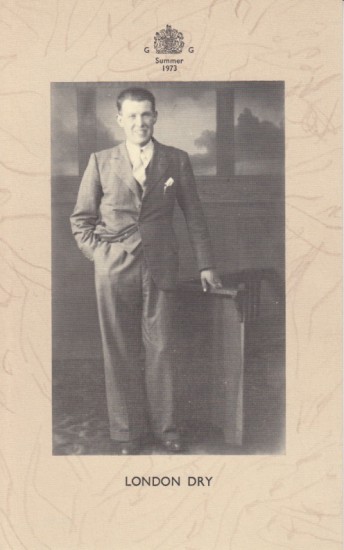The Works of Publius Virgilius Maro. Translated, Adorn'd with Sculpture, and Illustrated with Annotations, by John Ogilby
Virgil. (Publius Vergilius Maro)
London. Printed by Thomas Warren for the Author, and Are to Be Had at His House in Kings-Head Court in Shoe-Lane. 1654
Sold
A magnificent copy bound lavishly in red morocco and with the plates coloured beautifully by a contemporary hand.
First published in an unillustrated octavo version in 1649, John Ogilby (1600 - 1676), aware that his translation - he was self-taught - was inadequate, planned a new edition and a more lavish version, 'adorn'd with sculpture' as per the title and with elaborate and systematic notes. Ogilby commissioned the German painter Francis Cleyn for the illustration (it appears that only two of Cleyn's original works for the book survive) which was executed by William Faithorne, Wenceslaus Hollar and Peter Lombard (among others), the foremost etchers and engravers of the day. The plates, of considerable beauty, skill and interest, especially in exceptional colour and heightened with gilt as in the present copy, are situated within a long-standing tradition and corpus of illustration for Virgil's works - Virgil was taught in Roman schools while still living and the Aeneid in its day was praised as greater even than Homer's Iliad - beginning with near contemporary manuscripts (the earliest surviving examples date from the 4th and 5th centuries A. D.) and extending through the early and late mediaeval periods until Gruninger's first printed illustrated edition of 1502.
Virgil is reported to have read lines - and perhaps whole books - of the Aeneid to the Emperor Augustus and the epic legitimises Imperial rule by tracing Augustus' ancestry back to Aeneas and through him to Troy and the Greek gods; it seems clear that the Royalist Ogilby was keen to draw similar parallels with the court of Charles II (at the time of publication in exile) and his Royalist supporters. The founder of Britain, at least in legend (although mentioned by Geoffrey of Monmouth), was the Trojan Brutus, a descendant of Aeneas and therefore a predecessor of the rightful Stuart line and the exiled Charles. In addition, Ogilby dedicated the book to the Royalist William Seymour, Marquess and Earl of Hertford, Viscount Beauchamp and later, at the Restoration, Duke of Somerset, and each of the 101 plates in the work is dedicated to a Royalist supporter and features their arms (they were also patrons and helped defray Ogilby's cost for the work by subscription). Ogilby issued an edition illustrated with the same plates with Latin verse in 1658 and further editions of both versions were issued; the Great Fire of 1666 destroyed the majority of Ogilby's stock. Although Ogilby was mocked by the Augustans Pope and Dryden in terms of his verse - jealousy of a successful competitor explains this partially - Dryden did make use of copies of Ogilby's plates for his own Virgil and Pope too praised the illustrations in his Dunciad. Dryden and Pope's literary caveats aside, it is clear that Ogilby's Virgil is one of the most beautiful English illustrated books of the seventeenth century.
The exceptional colouring by hand with the additional heightening in gilt in the present copy - the vibrant colour is extended to all of the initials as well as the arms at the foot of each plate - suggests that this copy has a distinguished provenance: the colour appears to precede the rebinding of the book in red morocco and it seems likely that the portrait, frontispiece and the first plate were laid down at the time of binding rather than the time of colouring, but their is no indication as to ownership. Books with such elaborate colour were usually produced for a specific patron or for presentation as is plausibly the case here. It is worth noting that a copy owned by Charles II and bound by Samuel Mearne was a large paper copy but uncoloured and that a copy in the Royal Collection is also uncoloured; we can trace no other examples of Ogilby's Virgil with hand-coloured plates.
'The illustrations are remarkable for their attentiveness to the narrative and descriptive details, yet it would be a mistake to regard Cleyn as a bland imitator of Vergil or an artist lacking in creativity and originality ... He is both a skilled craftsman, and, at his best, a subtle and insightful interpreter of Virgil. Cleyn's rigorous attention to detail stems less from a pedantic desire to transform word into image than from a deliberate attempt to serve a particular 17th-century aesthetic - one that favors ornateness and an intricacy of design within a tightly compressed visual space. He had a habit of bringing together several separate, though related, narrative moments in a single image ... '. (David J. Califf).
'Les gravures ... sont au nombre de 104, y compris le frontispice, le portrait et une carte géographique. Plusieurs sont du célèbre Hollar. Elles ont d'abord paru dans la traduction anglaise de Virgile, par Ogilvy, imprimée en 1654 ... '. (Brunet describing the first Latin edition of 1658).
[Wing V610; see Brunet V, 1289 / 1290].
First published in an unillustrated octavo version in 1649, John Ogilby (1600 - 1676), aware that his translation - he was self-taught - was inadequate, planned a new edition and a more lavish version, 'adorn'd with sculpture' as per the title and with elaborate and systematic notes. Ogilby commissioned the German painter Francis Cleyn for the illustration (it appears that only two of Cleyn's original works for the book survive) which was executed by William Faithorne, Wenceslaus Hollar and Peter Lombard (among others), the foremost etchers and engravers of the day. The plates, of considerable beauty, skill and interest, especially in exceptional colour and heightened with gilt as in the present copy, are situated within a long-standing tradition and corpus of illustration for Virgil's works - Virgil was taught in Roman schools while still living and the Aeneid in its day was praised as greater even than Homer's Iliad - beginning with near contemporary manuscripts (the earliest surviving examples date from the 4th and 5th centuries A. D.) and extending through the early and late mediaeval periods until Gruninger's first printed illustrated edition of 1502.
Virgil is reported to have read lines - and perhaps whole books - of the Aeneid to the Emperor Augustus and the epic legitimises Imperial rule by tracing Augustus' ancestry back to Aeneas and through him to Troy and the Greek gods; it seems clear that the Royalist Ogilby was keen to draw similar parallels with the court of Charles II (at the time of publication in exile) and his Royalist supporters. The founder of Britain, at least in legend (although mentioned by Geoffrey of Monmouth), was the Trojan Brutus, a descendant of Aeneas and therefore a predecessor of the rightful Stuart line and the exiled Charles. In addition, Ogilby dedicated the book to the Royalist William Seymour, Marquess and Earl of Hertford, Viscount Beauchamp and later, at the Restoration, Duke of Somerset, and each of the 101 plates in the work is dedicated to a Royalist supporter and features their arms (they were also patrons and helped defray Ogilby's cost for the work by subscription). Ogilby issued an edition illustrated with the same plates with Latin verse in 1658 and further editions of both versions were issued; the Great Fire of 1666 destroyed the majority of Ogilby's stock. Although Ogilby was mocked by the Augustans Pope and Dryden in terms of his verse - jealousy of a successful competitor explains this partially - Dryden did make use of copies of Ogilby's plates for his own Virgil and Pope too praised the illustrations in his Dunciad. Dryden and Pope's literary caveats aside, it is clear that Ogilby's Virgil is one of the most beautiful English illustrated books of the seventeenth century.
The exceptional colouring by hand with the additional heightening in gilt in the present copy - the vibrant colour is extended to all of the initials as well as the arms at the foot of each plate - suggests that this copy has a distinguished provenance: the colour appears to precede the rebinding of the book in red morocco and it seems likely that the portrait, frontispiece and the first plate were laid down at the time of binding rather than the time of colouring, but their is no indication as to ownership. Books with such elaborate colour were usually produced for a specific patron or for presentation as is plausibly the case here. It is worth noting that a copy owned by Charles II and bound by Samuel Mearne was a large paper copy but uncoloured and that a copy in the Royal Collection is also uncoloured; we can trace no other examples of Ogilby's Virgil with hand-coloured plates.
'The illustrations are remarkable for their attentiveness to the narrative and descriptive details, yet it would be a mistake to regard Cleyn as a bland imitator of Vergil or an artist lacking in creativity and originality ... He is both a skilled craftsman, and, at his best, a subtle and insightful interpreter of Virgil. Cleyn's rigorous attention to detail stems less from a pedantic desire to transform word into image than from a deliberate attempt to serve a particular 17th-century aesthetic - one that favors ornateness and an intricacy of design within a tightly compressed visual space. He had a habit of bringing together several separate, though related, narrative moments in a single image ... '. (David J. Califf).
'Les gravures ... sont au nombre de 104, y compris le frontispice, le portrait et une carte géographique. Plusieurs sont du célèbre Hollar. Elles ont d'abord paru dans la traduction anglaise de Virgile, par Ogilvy, imprimée en 1654 ... '. (Brunet describing the first Latin edition of 1658).
[Wing V610; see Brunet V, 1289 / 1290].
pp. (xiv), 586. Folio. (410 x 280 mm). Engraved portrait of 'Johannes Ogilvus' by William Faithorne after Peter Lely, engraved frontispiece by Peter Lombard after Francis Cleyn, printed title in red and black, leaf with Ogilby's dedication to William Seymour, Earl of Hertford etc., two leaves with 'The Life of Publius Virgilius Maro', Eclogues I - X of the 'Bucolicks', Books I - IV of the 'Georgicks' and Books I - XII of the Aeneid illustrated with a double-page map by Hollar for the Aeneid and 101 etched or engraved plates each with dedication and arms at foot by Hollar, Lombard, Faithorne and others, all after Francis Cleyn and all with additional colouring and heightening in gilt by hand and the plate marks bordered in black or black and gilt, 28 head-pieces, 11 tail-pieces and 28 decorative or historiated 6-line initials also with colouring and heightening in gilt by hand; Ogilby's English verse with marginal notes and commentary in Roman type with proper nouns and quotations in italics, running headline throughout; plate for pg. 296 with slip pasted over dedication with replacement arms and text, portrait, frontispiece and first plate laid down presumably at the time of binding. Sheet size: 404 x 260 mm. Early eighteenth-century red straight-grained morocco, boards with elaborate roll tool borders with star-crowned coronets at corners to surround central tooled lozenges with coronets at points, banded spine with elaborate decorative tooling and blue morocco label with gilt title in seven compartments, board edges and turn-ins tooled in gilt, marbled endpapers, blue silk placemarkers, a.e.g.
#45544
